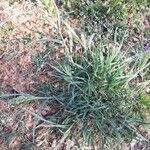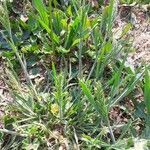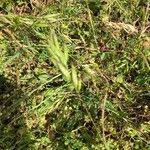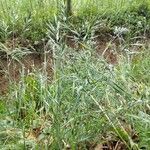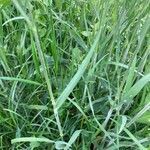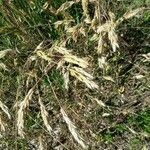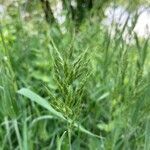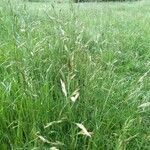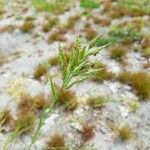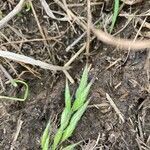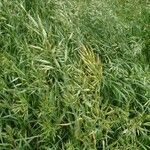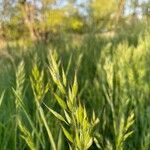Annual or sometimes biennial, caespitose. Culms 5–108 cm high. Leaves: basal sheaths puberulous to pilose; blade (3.5–) 7–22 cm long, (2–) 3–7 mm wide, puberulous to pilose. Panicles erect, contracted, (1.5–) 2.5–11 cm long; primary branches spreading. Spikelets erect, oblong or ovate or narrowly elliptic, 12–20 mm long, with 7–12 bisexual florets; pedicel 0.8–11.5 (–16.5) mm long. Glumes equal to unequal; lower glume 4.8–8 mm long, apically keeled or dorsally rounded, 3–5-nerved, with midnerve glabrous or puberulous and intercostal regions puberulous to hirsute; upper glume 5.5–9 mm long, dorsally rounded, 7–9-nerved, with midnerve glabrous or puberulous to hirsute and intercostal regions scabrous to villous. Callus blunt, glabrous or laterally scabrous. Basal lemma 7–9.5 mm long, with margins not tightly incurved, dorsally rounded, 7–9-nerved, scaberulous to pilose or hirsute; awn subapical, arising 1–1.5 mm below lemma tip, 3–9 mm long, straight or curved, entered by 3 nerves (but only 1 obvious). Palea equalling or slightly shorter than lemma, glabrous or rarely puberulous. Anthers 0.6–2.3 mm long.
Annual. Culms erect from a creeping or obliquely ascending base, 30–80 cm tall, minutely hairy immediately below inflorescence, nodes thinly hairy. Leaf sheaths pubescent; leaf blades linear, flat, 3–5 mm wide, soft, both surfaces pubescent; ligule ca. 1 mm. Panicle erect, usually dense, 5–10 cm; branches short; pedicels mostly shorter than spikelets, pubescent, spikelets many. Spikelets oblong, 12–20 × 4–6 mm, usually hairy, florets 6–12(–16), distal florets mostly sterile; rachilla internodes ca. 1 mm, with small bristles; glumes unequal, margins membranous, pubescent, obtuse, lower glume 4–5 mm, 3–5-veined, upper glume 5–8 mm, 5–7-veined; lemmas elliptic, 8–11 × ca. 2 mm in side view, papery, glabrous, prominently 7–9-veined, pubescent, margins membranous, apex obtuse, minutely 2-toothed, awned from 1–2 mm below apex; awn 5–10 mm, stout, straight; palea shorter than lemma, keels ciliate. Anthers 0.2–1 mm. Caryopsis shorter than or as long as palea. Fl. and fr. May–Jul. 2n = 28.
Tufted annual or biennial, up to 600 mm high; culms decumbent to erect. Leaf blade 50-150 x 3-4 mm, somewhat glaucous, flat, soft; ligule an unfringed membrane. Inflorescence a panicle up to 50 mm long, dense, stiffly erect; culms glabrous or minutely hairy below inflorescences; spikelets few. Spikelet 7-22 mm long, slightly laterally compressed, densely hairy to glabrous; glumes unequal, shorter than spikelet; lower glume 3-5-nerved; upper glume 5-7-nerved. Florets 5-many; lemma back rounded, lobed, awn 3-10 mm long, fine, not flattened, somewhat spreading and twisted, erect to bent; ovary with a conspicuous hairy appendage at apex; anther 0.5-1.0 mm long. Flowering time Oct.-Feb.
Annual or sometimes biennial, 3–10 dm; culms glabrous or often puberulent; sheaths and blades hairy, the latter 2–6 mm wide; ligule 0.5–2 mm; infl rather dense, erect, 3–10 cm, its branches usually shorter than the spikelets; spikelets 10–25 mm, 6–9-fld, soft-hairy or rarely glabrous; first glume 5–7 mm, 3(5)-veined; second glume broader, 5–9-veined, 6–9 mm, often awned; lemmas 7–11 mm, ca 7-veined, 1.5–2.2 mm wide on a side, the terminal teeth 1–1.5 mm; awns straight, erect, 3–9 mm; palea shorter than the lemma; anthers 0.2–2 mm; 2n=28. Native of Europe, sparingly intr. in our range in disturbed sites. (B. mollis)
Like B. commutatus but panicle dense, contracted with all pedicels shorter than spikelets.
A grass. It grows each year from seed. The flowering stems are 80 cm tall.
